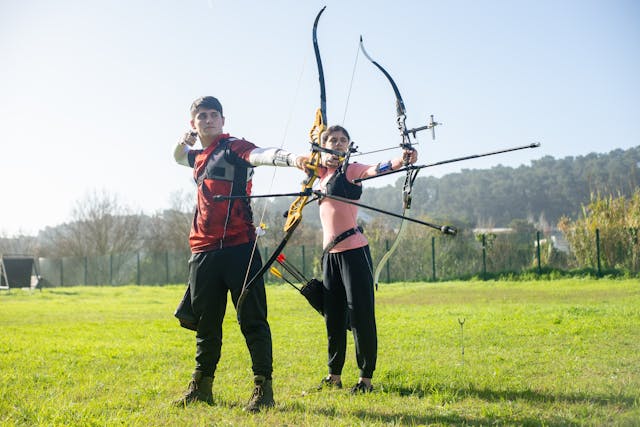
- Choosing the right type of archery bow is crucial for your success and growth in the sport, with a variety from traditional longbows to modern compound bows.
- Understanding basic archery terms is essential for selecting and using a bow effectively.
- Safety, regular maintenance, and familiarizing oneself with archery regulations are paramount for all archers, regardless of the bow type used.
- Archery remains an accessible sport for all, balancing between affordability for beginners and investment in quality gear for seasoned archers.
Exploring the Different Types of Archery Bows: A Comprehensive Guide
The journey into archery begins with a fundamental choice: selecting the right bow. This choice is pivotal, as it influences not only your archery experience but also your growth and success in the sport. Across cultures and centuries, various types of archery bows have been developed, each with unique characteristics and suited for different purposes. From traditional longbows evoking the spirit of medieval archers to modern compound bows engineered for precision, the range of options available today is vast.
This guide aims to explore the diversity of archery bows, providing insights into their design, functionality, and use cases. Understanding the nuances of each type can help archers at all levels make informed decisions, whether for competitive shooting, hunting, or recreational archery. Join us as we delve into the world of archery bows, where history and technology intersect to create a fascinating array of archery equipment.
Understanding the Basics of Archery Bows
Before venturing into the specifics of each bow type, it’s crucial to understand the basic components that form the backbone of these tools. According to the National Field Archery Association, a bow consists of a set of limbs connected by a riser, with a string spanning the length between the limb tips. These elements work in harmony to store and release energy efficiently, propelling arrows toward their targets with varying degrees of force and precision.
The terms “draw weight” and “draw length” are essential in the archer’s vocabulary, representing the force required to pull the string back and the distance pulled, respectively. These factors not only affect the bow’s performance but also need to align with the archer’s physical capabilities and intended use. Grasping these concepts is the first step in the archer’s journey, laying the groundwork for a deeper exploration of the types of archery bows and their distinct characteristics.
Types of Archery Bows
The archery world is rich with variety, offering different types of bows to cater to the preferences and needs of archers. Each type brings something unique to the table, from the simplicity and tradition of the longbow to the technological sophistication of the compound bow.
Recurve Bows

Recurve bows hold a special place in the tapestry of archery history, their lineage stretching back to the charioteers of ancient civilizations. These bows are distinguished by their unique design, where the tips curve away from the archer when the bow is unstrung. This design imbues the bow with a distinct aesthetic and enhances its mechanical efficiency, allowing for a more powerful shot from a compact frame.
The recurve bow’s versatility has been adopted across a myriad of cultures, each adding its nuances to its construction and use. In modern times, recurve bows have retained their prominence and are celebrated for their balance of tradition and performance. They serve as the only bow style permitted in Olympic competitions according to the World Archery Rulebook, highlighting their enduring relevance and appeal.
Advantages of Recurve Bows:
- Enhanced power from a shorter bow length due to their curved tips.
- It is versatile and suitable for both competitive shooting and hunting.
- Availability in takedown models, making them easy to transport and customize.
Disadvantages of Recurve Bows:
- The steeper learning curve for mastering shooting technique.
- It can be physically demanding, requiring good technique and upper body strength.
- Fewer features for customization compared to compound bows.
Selecting the right recurve bow involves considering your skill level, the bow’s purpose, and your physical capabilities. When considering recurve bows for beginners, look for one with a comfortable grip and a draw weight you can manage for multiple shots without fatigue. This ensures a smoother learning curve and a more enjoyable archery experience.
If your focus is on recurve bows for hunting, prioritize durability and higher draw weight to ensure your bow can handle the demands of the hunt. Regardless of your purpose, always ensure the bow’s length is appropriate for your draw length, as this affects both comfort and accuracy. Taking these factors into account will help you find a recurve bow that not only meets your needs but also enhances your archery journey.
Compound Bows

Compound bows are the high-tech gadgets of the archery world. They’re designed with gears and pulleys that make shooting them easier and more powerful than traditional bows. Imagine being able to pull back a really strong bow without feeling like it’s that hard to hold it there. That’s what makes compound bows special. They let you focus more on aiming without tiring your arms out, which is great for target shooting or hunting.
The secret of a compound bow is its cam and pulley system. These little wheels at the ends of the bow do the heavy lifting, so to speak. When you pull the string back, the wheels turn and make the bow easier to hold. This cool feature is called “let-off,” and it’s a game-changer because it lets you take your time aiming without feeling like you’re holding up a heavy weight. This means you can shoot more accurately and for longer periods without getting tired.
Where compound bows really beat the competition is in their accuracy and power. Thanks to their design, you can shoot arrows really precisely and with a lot of force. Plus, you can adjust the bow to fit you perfectly, like adjusting the seat and mirrors in your car. This makes sure you can shoot comfortably and hit your target spot-on, whether you’re in a competition or out hunting.
When looking for the best compound bows, think about what you need it for. Do you want something for target practice, hunting, or just for fun? Look for a bow that fits your size, is adjustable (so you can make it perfect for you), and shoots arrows fast. For target shooting, also check out the bow’s precision features. Finding the right compound bow means balancing power, accuracy, and how it feels to hold and shoot.
Longbows

Longbows have a storied history, stretching back to the medieval ages, where they were celebrated for their pivotal role in warfare. These traditional longbows were crafted from a single piece of wood, often yew, which allowed for both strength and flexibility—a combination that was essential for the long draw distances required. Their design is remarkably simple, with the bow’s length often matching or exceeding that of the archer, allowing for powerful shots over considerable distances. This simplicity, however, belies the skill required to master the longbow, a skill that was honed over the years by the archers of old. Today, traditional longbows hold a special place in the hearts of archery enthusiasts who appreciate the connection to history and the raw, unaided challenge they present.
Unlike their mechanical descendants, longbows do not rely on cams, pulleys, or other innovations to enhance performance. This direct connection between archer and bow, where success lies solely in one’s technique and strength, is immensely appealing. The elegance of the longbow, with its smooth, continuous lines and lack of additional hardware, offers a minimalist beauty that stands in contrast to the more complex designs seen in contemporary bows.
When comparing longbows for traditional archery to other modern bow types, several key differences emerge:
| Feature | Longbow | Recurve Bow | Compound Bow |
| Design | Simple, single-piece construction | Curved tips for increased power | Mechanical design with cams and pulleys |
| Ease of Use | Requires considerable skill and strength | Easier to learn with a gentle learning curve | Easiest to hold drawn, thanks to let-off |
| Portability | Less convenient due to size | More portable, especially takedown models | Compact and portable |
| Adjustability | Non-adjustable, one-piece design | Limited adjustability | Highly adjustable for draw weight and length |
| Suitability | Preferred for traditional archery | Versatile, used in the Olympics | Favored for hunting and precision target shooting |
In summary, while the longbow may seem primitive compared to the technological marvels of compound and recurve bows, its appeal lies in its historical significance and the purity of the archery experience it offers. For those drawn to traditional longbows, the challenge is not just about hitting the target but connecting with the ancient roots of archery. Similarly, longbows for traditional archery serve as a testament to the enduring legacy of this elegant weapon, inviting archers to step back in time and embrace the fundamentals of the sport.
Crossbows
Crossbows bring a unique twist to traditional archery, combining the principles of a bow with the mechanics of a gun. Originating in ancient China, their design has evolved significantly, offering modern archers a powerful and precise tool. Unlike traditional bows that require the archer to draw and hold the string manually, crossbows use a locking mechanism to hold the string in a drawn position. This allows for more consistent energy and force in each shot, making crossbows particularly appealing for both hunting and target shooting.
Advantages of Using Crossbows:
- Ease of Use: Once the crossbow is cocked and loaded, maintaining the drawn position doesn’t require continuous physical effort. This allows archers to focus more on aiming, making crossbows especially user-friendly for beginners or those with physical limitations.
- Power and Accuracy: Crossbows are designed for precision. With the ability to use scopes and the stability provided by their design, achieving accuracy is more manageable, making them ideal for hunting. Speaking of best crossbows, these are often judged on their accuracy and power, which are critical factors for successful hunting and target shooting.
- Versatility: Crossbows can be used in a variety of hunting situations. Whether it’s crossbows for deer hunting or smaller game, they offer the power needed to ensure a humane and ethical kill, thanks to their high velocity and impact.
Safety Considerations and Regulations:
- Handling: Due to their gun-like design and mechanism, handling a crossbow safely is paramount. Always pointing the crossbow in a safe direction and ensuring it is only loaded when ready to shoot are fundamental safety practices.
- Maintenance: Regular maintenance is crucial to ensure the crossbow operates safely and effectively. This includes checking the string, limbs, and bolts for wear and damage.
- Regulations: Crossbow use is subject to specific regulations that vary by region, including hunting seasons and licensing requirements. It’s essential for users to familiarize themselves with these laws to ensure they are hunting legally and ethically.
Frequently Asked Questions
What draw weight should I choose?
Select a draw weight you can comfortably pull and hold for several seconds. It should allow you to shoot accurately without straining.
How do I string my bow?
Use a bow stringer to ensure safety and protect the bow’s limbs. This tool helps apply even pressure, reducing the risk of damage.
How often should I replace my bowstring?
Inspect your bowstring regularly for wear and replace it every 2-3 years or sooner if you notice fraying or damage.
Can I adjust the draw length on my bow?
Yes, most modern compound bows allow for draw length adjustment. Recurve bows have fixed lengths, so choose one that fits your draw.
What maintenance does my bow need?
Regularly check for limb damage, string wear, and loose fittings. Keep your bow clean, and store it in a dry place to prevent warping.
People Also Ask
What are the best brands for recurve bows?
Popular recurve bow brands include Samick, Hoyt, Bear Archery, and Win&Win. Each offers a range of options suitable for beginners and advanced archers.
Are compound bows suitable for beginners?
Yes, compound bows are suitable for beginners due to their adjustable draw weight and let-off feature, which reduces the strain of holding the string at full draw.
Is archery an expensive hobby?
Archery can vary in cost. Beginners can start with affordable equipment, but as skills improve, investing in higher-quality bows and accessories increases the cost.
How long does it take to become proficient in archery?
Proficiency in archery depends on the frequency of practice and instruction quality. Most archers see significant improvement within a few months of regular practice.
Can I use a longbow for hunting?
Yes, longbows can be used for hunting, provided they have the appropriate draw weight to ensure an ethical and humane kill.




